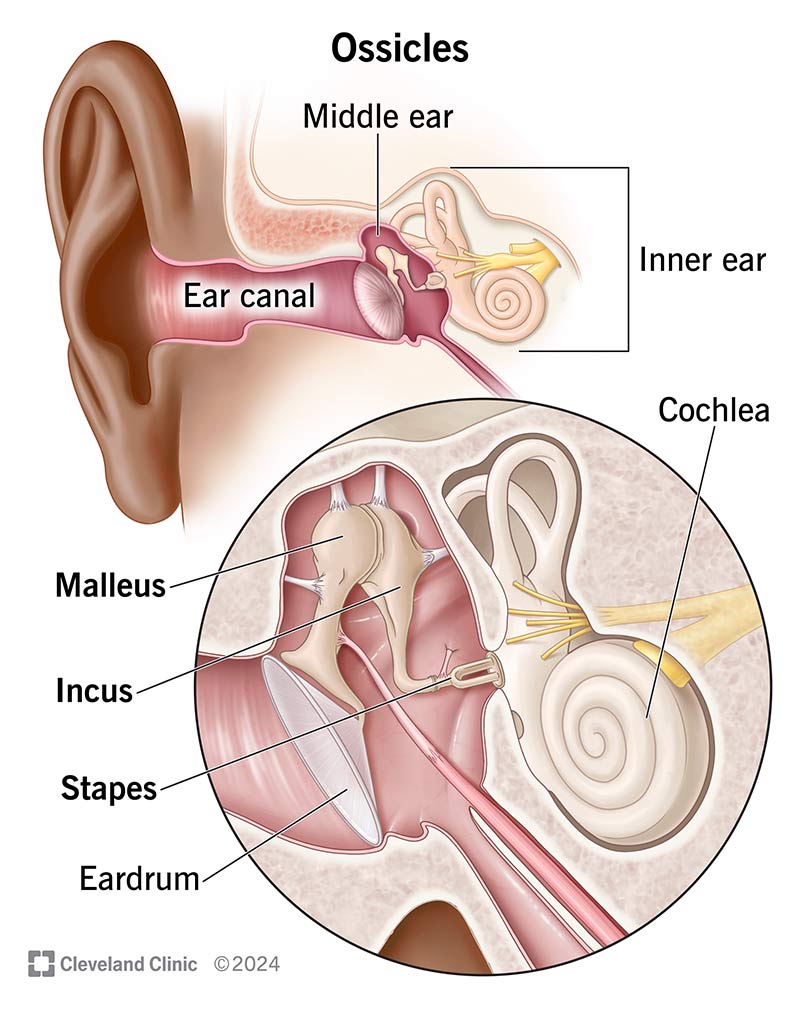Your ossicles are three bones in your middle ear. They are the malleus (hammer), incus (anvil) and stapes (stirrup). Together, they form a chain that pushes sound vibrations from your eardrum to your cochlea. These delicate structures are the smallest bones in your body. But they play a key role in helping you hear.
Advertisement
Cleveland Clinic is a non-profit academic medical center. Advertising on our site helps support our mission. We do not endorse non-Cleveland Clinic products or services. Policy

Your ossicles — the malleus, incus and stapes — are three tiny bones in your middle ear. They move sound vibrations from your eardrum to your cochlea, which is part of your inner ear. There, the vibrations convert into electrical signals that reach your brain so you can hear.
Advertisement
Cleveland Clinic is a non-profit academic medical center. Advertising on our site helps support our mission. We do not endorse non-Cleveland Clinic products or services. Policy
Your ossicles are the smallest bones in your entire body, but they have a big job. They’re essential to your hearing. Issues with your ossicles can lead to hearing loss.
Your ossicles interact to push sound vibrations from your eardrum (tympanic membrane) to your cochlea. They amplify (boost) the sound signal along the way. This means that the vibrations that reach your cochlea are bigger than when they leave your eardrum.
To understand how your ossicles work, think of them by their collective name: the ossicular chain. Each bone is an individual link in a chain reaction, where one movement leads to the next. Here’s how your ossicles help you hear:
The vibrations inside your cochlea cause the fluid inside to displace sensory hair cells. The hair cells release electrical signals that your brain understands as sound.
Your ossicles form an interconnected chain inside your middle ear. They’re in between your eardrum and the most important auditory (hearing) structure within your inner ear, your cochlea.
Advertisement
The malleus is also called the hammer because of its shape. Key parts include the head, the neck, the anterior and lateral processes, and the handle. The handle attaches to your eardrum. The handle moves the entire malleus when your eardrum vibrates.
The head of the malleus attaches to the incus via the incudomalleolar joint.
The incus is also called the anvil because the malleus (hammer) strikes it with sound vibrations. The parts of the incus include the body, which comes into direct contact with the vibrating malleus. The incus also has a short limb and a long limb.
The long limb of the incus attaches to the stapes via the incudostapedial joint.
The stapes resembles a stirrup and sometimes goes by that name. It’s the smallest bone in the human body, measuring only a few millimeters in both width and height. It has a head, neck and two limbs attached to a base, or footplate. The head of the stapes is attached to the long limb of the incus. The footplate transmits sound vibrations to the oval window of your cochlea.
Problems with your ossicles can lead to conductive hearing loss. This happens when sound vibrations can’t reach your inner ear. Related conditions that impact your ossicles (and can lead to hearing loss) include:
Symptoms include:
Your healthcare provider may perform the following tests:
Advertisement
Treatments depend on the condition causing the problem. These may include:
The best thing you can do for your ossicles is to take steps to prevent ear infections and seek treatment if you’re noticing changes in your hearing. Conditions that affect your ossicles are often treatable. But delaying treatment can lead to long-term damage. It’s best to see a healthcare provider as soon as possible.
They may be tiny, but your ossicles are crucial when it comes to your hearing. These three bones catch the vibrations from your eardrum and pass along the signal, bone by bone. They don’t stop until the sound reaches your inner ear, where your cochlea transforms vibrations into signals your brain perceives as sound. Keep your ossicles healthy by seeing a healthcare provider at the first sign of a hearing issue.
Advertisement
If you have conditions affecting your ears, nose and throat, you want experts you can trust. Cleveland Clinic’s otolaryngology specialists can help.

Last reviewed on 01/29/2025.
Learn more about the Health Library and our editorial process.